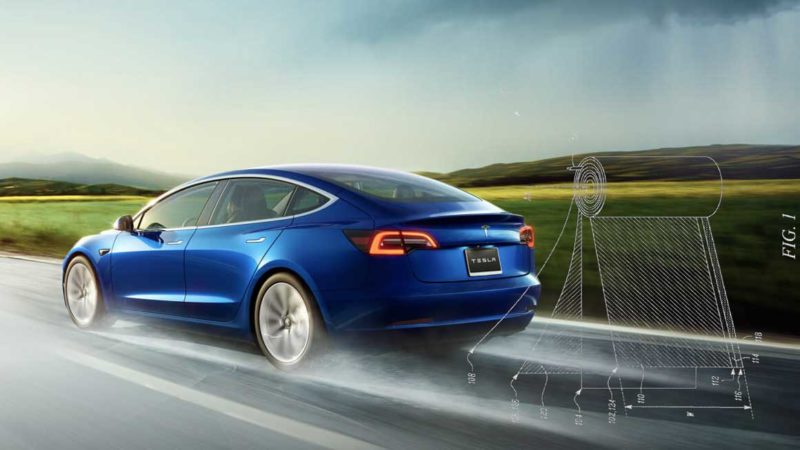Tesla’s highly anticipated Battery Day is just four days away, and Elon Musk has taken to Twitter again saying that: “It will be very insane.”
It’s a favourite superlative of the at-times eccentric CEO, but the rise of the electric car and Tesla’s subsequent disruption of the entire auto industry suggests it is worth the attention.
Electric cars are, of course, powered by batteries. Hence the incredible interest in Tesla’s Battery Day, which is set to unveil Tesla’s improvements in battery technology on September 22, at the same time as the company’s annual stockholders’ meeting.
New leaks on Thursday about what may be included in Battery Day revelations are also adding fuel to the flame, so to speak.
Electrek leaked an image of a new battery cell, that is thought to be a tabless battery made in-house by Tesla as part of its “Roadrunner” project, that has much larger dimensions (10 times in fact) than the 2170 cylinder typically used in Tesla vehicles. (Teslarati gives a good run down on what this may mean, though we note we have not independently confirmed whether this particular leak is in fact connected with Tesla).
However, as indicated by Musk, Tesla’s Battery Day will reveal “many exciting things.”
Many exciting things will be unveiled on Battery Day 9/22 ⚡️
— Elon Musk (@elonmusk) September 11, 2020
So, to get an extensive run down for you on what Musk has said could be the most important day in Tesla’s history, we reached out to battery expert Dan Blondal, who is CEO at Canada’s Nano One, a company that produces li-ion cathode materials.
“High energy density and million-mile batteries will accelerate the adoption of passenger and industrial electric vehicles, hastening our transition to net zero transportation emissions,” says Blondal.
Blondal lists million-mile batteries, as well as in-house manufacturing and the integration of technologies from companies it has acquired such as Maxwell and Hibar amongst the revelations that can be expected on Battery Day.
He also says, “I’m anticipating innovation news on silicon anodes, cobalt reduction in their cathodes and actions to improve the environmental sustainability of their supply chain.”

The million-mile battery
Blondal says the most important thing about the “million mile battery” – despite the fact that most drivers will never need anything close to a million miles – is that a battery that can cycle 4,000 times before seriously degrading puts worries about dead batteries to rest.
But the real value in the million-mile battery for the average driver, he says, “is its underlying durability because this enables tangible benefits like aggressive charging, longer range, smaller sizes and lower costs.”
“You need a big battery for the occasional road trip and energy density makes it more efficient. At 15,000 miles (about 24,000km) per year, the average US driver doesn’t need 4,000 cycles because they are only using 50 to 100 full charge cycles in a year.
But, “4,000 cycles and million-mile lifespans will be important to buses, taxis, fleet vehicles and renewable energy storage where daily depletion of the battery and low cost of ownership, necessitate it,” says Blondal.
He adds that shorter range electric vehicles will also benefit from longer-lasting batteries.
“It is interesting to note that mass-market entry-level vehicles will also need the increased cycle life because their smaller batteries will need more frequent charging. This need is already being addressed with low cost LFP in Asia and may see NMC as an alternative solution if durability and cost improvements ever allow.
“If we can clear these hurdles, it will lead to mass EV adoption and a carbon neutral future.”
Single crystal cathodes
The battery developments that will allow the long-life cycling of rechargeable batteries include nickel-manganese-cobalt (NMC) and long range Lithium Iron Phosphate (LFP) , says Blondal.
As covered previously by The Driven, single crystal cathodes are crucial to this.
“In NMC batteries, lithium cycles in and out of the cathode through large clusters of crystals that are prone to side reactions and degradation,” says Blondal.
“Protective coatings can be applied to the surface of the clustered crystals to reduce unwanted reactions but repeated charging damages the coating, as clusters of crystals expand, contract and break apart. Single-crystal cathodes can be formed that are less prone to cracking and with an added coating they can also resist side reactions.”
He explains that this means long-life “million mile batteries” are ideal for more demanding applications like robo-taxis, as well as being better suited to ultra-fast charging.
But, he adds, “making these coated single crystals remains complex and cost prohibitive.”
Higher energy density
One development Blondal thinks will be a major step forward for batteries is energy density. As hinted at by Musk in August, an energy density of 400Wh/kg could even enable electric flight.
“Energy density is the most important along with fast charging and cost,” says Blondal.
“Essentially, we have to develop batteries with greater fractions of the active energy storing materials (cathode and anode) and reduced fractions of inactive materials (copper, aluminum and separator foils; packaging and structural components; thermal and battery management systems).”
Blondal thinks that BYD’s Blade battery, which utilises lithium-iron phosphate chemistry, may be a catalyst for future Tesla batteries.
“On the LFP front, there has been major investment and innovation at the cell level, such as BYD’s Blade Battery. It leverages LFP’s stability and enables denser packing of cells for significantly increased driving range,” he says.
Silicon anode technology
When Tesla published its Battery Day page, the media went wild with speculation on whether Tesla was working with a company called Amprius which uses silicon nanowire anodes in its batteries. This technology has a much higher energy density than typical EV batteries but because silicon, “ expands like crazy during discharge,” says Musk, “cycle life is usually bad.”
Blondal notes that if this problem can be dealt with, there is promise for using more silicon in batteries.
“From what I understand, Tesla, like many of their peers, is already using a modest amount of silicon in their anodes in order to boost energy density. If Tesla can solve silicon’s cycle life issues or acquires a company working on it, then we may see them moving quickly to higher ratios of silicon in their anodes,” he says.
“Silicon anode innovations can help and so can durability enhancements in cathodes and electrolytes.
“Custom cell designs like the Blade battery enable denser packing with fewer structural components and lighter thermal management systems.
“Solid electrolytes have the potential to enable ultra-thin lithium anodes and reduced thermal management needs, but the interfacial and manufacturing scale-up challenges are monumental.”
He says that Nano One’s contributions to these challenges is focused on the cathode with cost reductions, durability enhancements and next gen materials that improve the interface with advanced and solid electrolytes.
Super caps vs dry electrode technology
Much speculation has been about whether Tesla acquired Maxwell Technologies for its work super capacitors, or dry cell electrodes.
“Super caps may play a modest role in future battery packs, but I think it is Maxwell’s dry electrode technology that aligns it with Tesla’s cell manufacturing ambitions,” says Blondal.
“Anode and cathode active materials are powders mixed into inks and applied as coatings on thin metal foils before being dried in ovens and rolled into cylindrical cells. Maxwell and a handful of other companies have developed dry additives that allow the powders to be pressed on to the foils without drying. This could improve one of the stages in cell manufacturing and seems to be aligned with Tesla’s ambitions to make their own cells.”
Future battery developments
While Tesla appears to be far ahead of other EV makers in terms of autonomy and battery technology, Blondal says that it may face challenges in the future as other car makers and startups progress their own technologies.
“As an early adopter of cylindrical cells, Tesla chose an off the shelf form factor that enabled it to scale early and race ahead, but it may ultimately limit the energy density of its battery packs,” he says.
“As we are seeing now from BYD’s blade battery development, they have a game-changing cell design and battery pack enabled by the unique properties of LFP, with a step function improvement in energy density and range.
“Tesla has tremendous R&D and financial horsepower, but it will still be very challenging for them to shift their EV battery platform in response to newer designs from established and emerging EV makers. An announcement on this topic at Battery Day would help Tesla de-risk this competitive threat.”
Environmental sustainability
Finally, a big concern about the rise of electric vehicles is the impact of mining and eventually how batteries will be repurposed or recycled.
Blondal thinks that this will be another important topic that will come under the spotlight on Battery Day.
“One topic we’ve seen a lot of conversation around of late is Elon Musk’s plea with miners for environmentally sustainable sources of nickel and other battery metals,” he says.
“The reality is that increased demand and rising commodity prices will be what drives investment in sustainable battery grade metals. But innovations like Nano One’s can also address this need by pushing cathode waste streams back to the refiner where they can be properly recycled and by integrating with raw material refiners to consolidate the supply chain, eliminate waste and provide cost effective and environmentally sustainable materials.”

Bridie Schmidt is associate editor for The Driven, sister site of Renew Economy. She has been writing about electric vehicles since 2018, and has a keen interest in the role that zero-emissions transport has to play in sustainability. She has participated in podcasts such as Download This Show with Marc Fennell and Shirtloads of Science with Karl Kruszelnicki and is co-organiser of the Northern Rivers Electric Vehicle Forum. Bridie also owns a Tesla Model Y and has it available for hire on evee.com.au.

